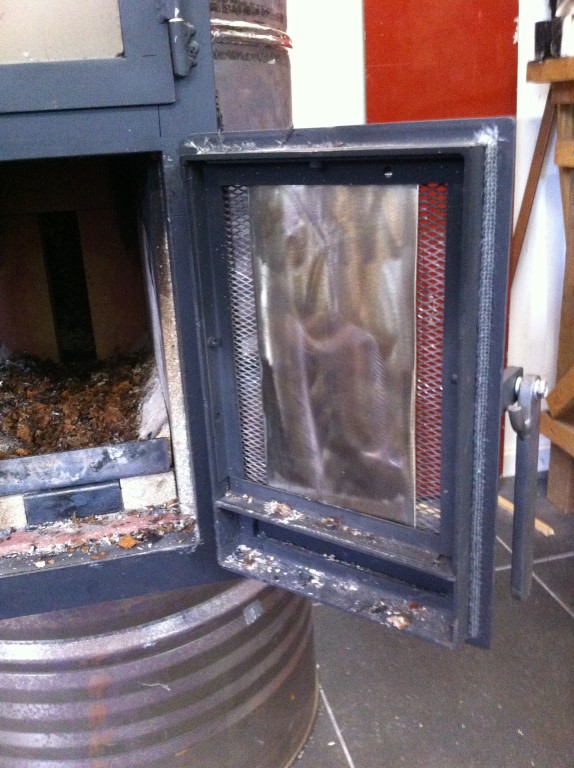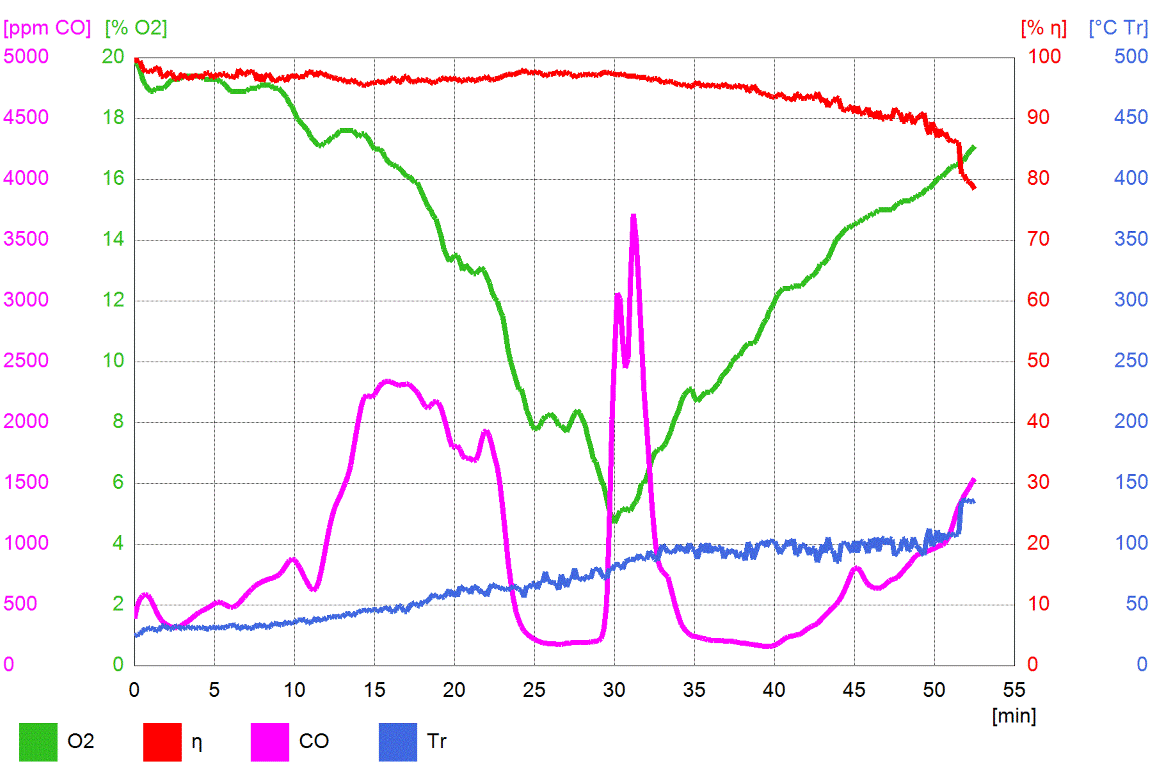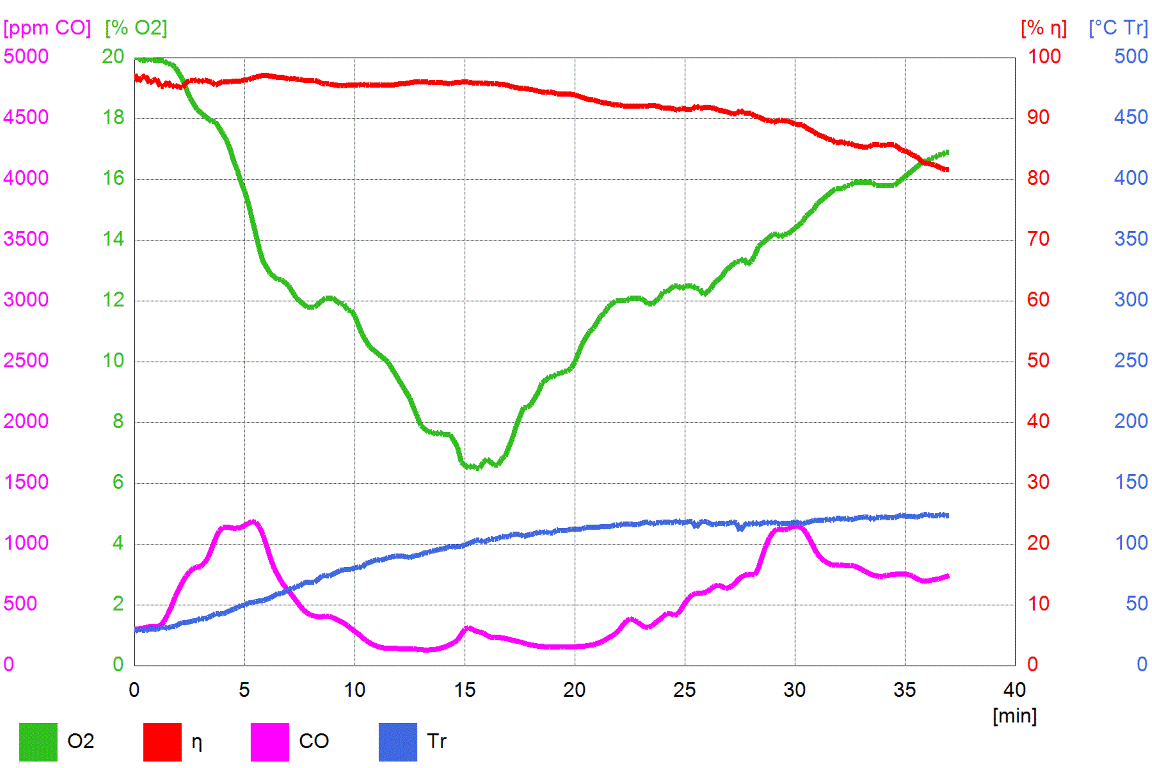|
|
Post by peterberg on May 30, 2019 9:26:00 GMT -8
Is the "stumbling block" still omitted from the design? Yes, it is. I am in the process of ticking a rather short list now. One of the unticked items is whether the thing will work correctly without the lower riser floor. And the question is then in case it isn't, would the stumbling block correct that. Given the choice between the stumbler and the raised firebox floor I would have the stumbler. Will this design be more tolerant of slightly green wood? Depends on your definition of "slightly green". My definition: anything below 15% moist is good, anything above 20% is bad. The small margin between those is only doable but second choice. Nothing new here, I'd say. |
|
|
|
Post by peterberg on May 30, 2019 9:43:38 GMT -8
Some days ago I swithched from a low horizontal opening to two narrow vertical openings. Works remarkably well, the idea is to provide air through the door frame left and right instead of through the door. And of course still without any secondary air provision. This is the fourth size I tried, being adequate now.  |
|
|
|
Post by patamos on May 30, 2019 11:46:34 GMT -8
That vertical side air feed bodes well for a sliding door method (see: donkey32.proboards.com/thread/3528/tsr-inverse-sliding-door) in which the size of the air intake can be shaped by the thickness of plaster behind the glass. Although your air trajectory might be more straight in along the sides towards the back of the firebox, whereas with the sliding door the air will be turning 90 degrees and making more turbulence near the front. The nice thing about the old slot at the bottom of the door is/was the concentrated blast of air for fast start up. But that can be managed in other ways. |
|
|
|
Post by Lucian on May 31, 2019 2:16:36 GMT -8
And last but not least, ran the test 4 times wthout floor channel at all. ... Conclusion so far: reliability with open door is somewhat better as compared to floor channel et al. ... Nothing changed during this run, 2/3 load of dense lumber scraps. Again, no secondary air provision at all. This is great. The floor channel space can still be very useful by replacing the metal tube with a grate and a long narrow ash tray under it (easily made from a dry-wall "C" profile).
The horizontal air slot at the door bottom should be closed during most of the burn.
Opening it only at the end of burn would provide forced under-air through the grate, into the coals. This would consume them faster and thus shorten the coal phase (when the stove is losing more heat through the chimney than it is gaining from the coals). This way, one could safely close the chimney damper sooner, with no risk of CO leaking. Ash cleaning would also be easier: just sweep the ashes through the grate, then extract and empty the tray.
(obviously, when opening the lower horizontal air slot, one would close the regular air supply, to force the air under the grate)
|
|
|
|
Post by marcios on May 31, 2019 13:31:18 GMT -8
Hi Peter and everyone, new here! (poor english, sorry) My experience is only a boiler I build in the past by digging 1.7 meter high a clay ground slope next to the house, heating 200lt 70/80C for 3 days with 20kg fuel, if I don't forget. The cover with bricks, vermiculite and other materials. Not too much smoke, but still a lot of heat loss. Ended up to easy solar energy. Thinking about reactivate the boiler when coming across with yours fantastic cores, and also for a little heater inside. Let me tell something from my recent search. The door of the picture above (screenshot from video) makes a suggestion for an air inlet door configuration experiment that, if I may say, approaches your investigation, including the front 90 degree air turning as patamos sliding glass door provides. Aside the secondary air configuration/control, variants could be more "easily" test through a external main air feed gate/valve plus balance control gates for each side/gap/opening in the hollow frame, so that you can vary total volume air feed and distribuition form independently (almost, with compensations). Furthermore, in the video referred the fire box floor is bellow door bottom level, could be another parameter to consider? Despite the work and challenge to build a hollow square with 4 balance controls (or 3?), in the long run that can do us happier, doesn't it? imgur.com/Qho9Dfq |
|
|
|
Post by peterberg on Jun 1, 2019 7:20:41 GMT -8
The floor channel space can still be very useful by replacing the metal tube with a grate and a long narrow ash tray under it (easily made from a dry-wall "C" profile). The horizontal air slot at the door bottom should be closed during most of the burn. In my experience, having a grate under the fire in a batchrocket of whatever construction is hardly a plus. The ashes are getting awfully hot in this configuration and there's very little left volume-wise. Which means there's almost no charcoal left and the remaining mineral ashes are "fused together" in lumps. Very easy to take out, and when rubbed between one's fingers what remains is a grey-ish, sharp sand. Far from as dusty and messy as one would expect of wood ash. |
|
|
|
Post by peterberg on Jun 1, 2019 7:31:03 GMT -8
...in the video referred the fire box floor is bellow door bottom level, could be another parameter to consider? Despite the work and challenge to build a hollow square with 4 balance controls (or 3?), in the long run that can do us happier, doesn't it? Hi Marcios, welcome to the boards. Certainly, I don't intend to implement something that's hard to make, please don't worry. At the moment my goal is to deliver a design that's capable of running open, so no door in there. Just for people who like to have a door in heaters that are situated in a domestic situation, like myself, I try to come up with an air provision that's as easy to make as possible. |
|
|
|
Post by peterberg on Jun 1, 2019 10:17:00 GMT -8
It's getting warmer inside and outside the house... Despite that, I keep burning fuel nearly every day. Yesterday's test run is done to establish whether it could be run with a riser floor that's level with the firebox. To my regret, this doesn't seem to be the case.  This happens to be a cold start, 2/3 firebox' load, tinder-dry small lumber scraps. At the mark of 28 minutes oxygen level took a steep dive, resulting in not enough air to keep combustion stable. Besides that, the big bulb in CO level between 11 and 24 minutes left also much to be desired. Funny enough, the resulting averages weren't as bad as expected, burn came on very slow. O² 13.7%, eff. 95.1%, CO 928 ppm, end temp 69.8 ºC. Today's run was done with a stumbler incorporated, 30x30 mm at the exact middle of the top box' depth. Also, the riser's floor still level. I made sure the fuel and circumstances being the same as before. So cold start, 2/3 filled using from the same batch of tinder-dry lumber scraps.  Looks much better now, especially the very moderate start and end CO bumps, fire development was much quicker. Remember, this start bump is typical for a cold start, most of the time it's absent when started warm. The only difference in the averages is in the CO level, as expected. O² 12.9%, eff. 92.6%, CO 536 ppm, temp 95.0 ºC. The whole of the setup seems to run much hotter, reflected by the higher end temp. Temperature measured on the side of the top barrel went up to 250 ºC (482 ºF), which can be considered at the high end during this test series. I'll repeat this last run tomorrow and maybe also Monday to establish whether or not this is a one-off result. |
|
|
|
Post by whazzatt on Jun 1, 2019 11:55:27 GMT -8
...with a riser floor that's level with the firebox Any pics of this? |
|
|
|
Post by peterberg on Jun 1, 2019 12:31:46 GMT -8
...with a riser floor that's level with the firebox Any pics of this? No... I leveled it out with sifted ashes. That would be a grey ash floor seen through the port wouldn't it? |
|
|
|
Post by peterberg on Jun 5, 2019 11:59:02 GMT -8
Development goes on at a steady pace. I did some check runs to establish stability of the system. One was done with bits and pieces of very dry beech, known due to its notoriously quick pyrolysis development. I have to say I am very pleased with the result.  This was a cold start, door open a crack, riser level with firebox, stumbler installed. Door closed as soon as the temperature in the chimney was over 100 ºC (212 ºF). I would call this a nice run, averages O² 12.4%, eff. 92.5%, CO 480 ppm, temp 92.8 ºC. Today I welded a new subframe, meant to be mounted between the door frame and the refractory core. Fairly large slits left and right in the inside and outside, solely made to establish how it would behave and what the minimum size of the air inlets would be. I am mighty pleased with the results so far, burning is quite calm and no big spikes. To the eye, the fire seems to be running healthy with no flames directed to the air inlets. Total of the established air openings are less than with the slits in the door. Tomorrow or the day after I'll buy a length of larger rectangle steel duct to replace the frame produced today. I am definitely on the path of vertical side air feed, plans are to have it running coming weekend with the new air frame. Patamos, you were right, this works so much nicer overall. Cold start is easy when the door is open a crack, glass of the door stays clear so far. |
|
|
|
Post by esbjornaneer on Jun 6, 2019 2:22:07 GMT -8
I am very pleased that it sounds like you are back to a fully glazed door. I was concerned about how it would be possible to close the air inlets in the door. Hope it will be easy in the 'air frame'. Thanks for all the updates.
|
|
|
|
Post by travis on Jun 6, 2019 6:00:14 GMT -8
Will be good to see a photo of this! I just got a rough test stove finished this evening and its going very well even though the bricks are soaked! Using plain red clay bricks to test viability for a more affordable stove for people here. Im very excited so far.
|
|
|
|
Post by peterberg on Jun 7, 2019 0:37:42 GMT -8
I'll try to shoot some pictures today. This air frame is in development stage, nothing definitive. It might even be ditched in favor of a conservative air inlet. I'm doing this development for a Dutch guy, building and selling one of my older designs. He wants to switch to selling complete cores accompanied by diverse sets of plans for DIY people.
|
|
|
|
Post by independentenergy on Jun 7, 2019 9:05:33 GMT -8
Peter sorry I didn't understand if you left the drawing without a door.
another thing, for your tests that ISA did you use?
|
|